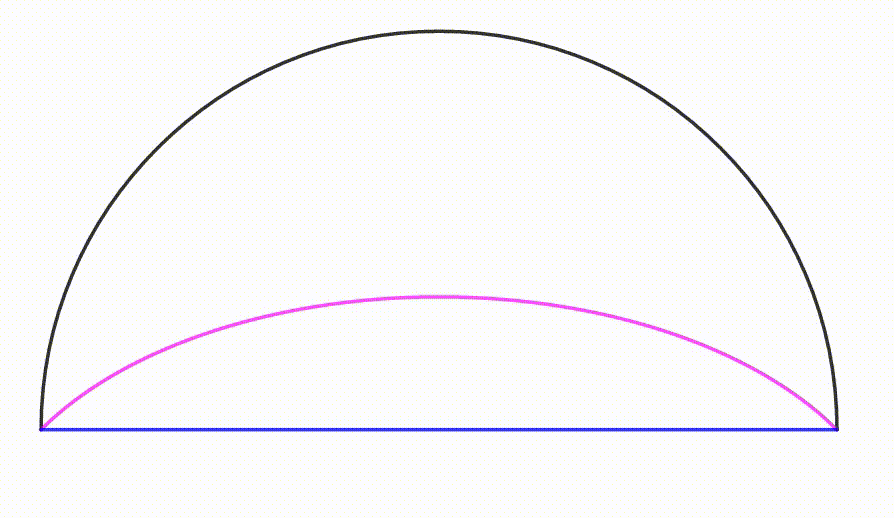Dynamic Geometry: P48
 The diagram shows a semicircle with radius
. A point is freely moving on its arc. We use this point and the diameter to draw a blue triangle. The yellow square is inscribed in the blue triangle at any moment. The center of the square (green point) traces a
locus
(pink curve). The area bounded by the pink curve and the black semicircle's diameter can be expressed as:
The diagram shows a semicircle with radius
. A point is freely moving on its arc. We use this point and the diameter to draw a blue triangle. The yellow square is inscribed in the blue triangle at any moment. The center of the square (green point) traces a
locus
(pink curve). The area bounded by the pink curve and the black semicircle's diameter can be expressed as:
where , , and are positive integers ; and are coprime so are and . Find .
The answer is 17.
This section requires Javascript.
You are seeing this because something didn't load right. We suggest you, (a) try
refreshing the page, (b) enabling javascript if it is disabled on your browser and,
finally, (c)
loading the
non-javascript version of this page
. We're sorry about the hassle.
The the center of the semicircle be O ( 0 , 0 ) , the origin of the x y -plane. Let A B be its diameter such that A ( − 1 , 0 ) and B ( 1 , 0 ) , the point on the arc be P ( u , v ) and the center of the square be C ( x , y ) . Let the side length of the square be s and the height of △ P D E be α s ; then ( 1 + α ) s = v .
Let the top-left vertex of the square be D ( x d , s ) . Draw D B ′ parallel to P B . Then we note that △ P D E and △ D A B ′ are similar, therefore
A B ′ D E 2 − s s s 2 ⟹ s ⟹ y = s α s = α = α = s v − 1 = ( v − s ) ( 2 − s ) = 2 v − 2 s − s v + s 2 = 2 + v 2 v = 2 s = 2 + v v Since ( 1 + α ) s = v
By similar triangles again,
x d + 1 u − x d 2 u − 2 x d x d ⟹ x = α = s v − 1 = 2 v = v x d + v = 2 + v 2 u − v = x d + 2 s = 2 + v 2 u − v + 2 + v v = 2 + v 2 u
Then we have:
x 2 + 4 y 2 x 2 + 3 y 2 + 2 y x 2 + 3 ( y + 3 1 ) 2 3 4 x 2 + 9 4 ( y + 3 1 ) 2 = ( 2 + v ) 2 4 ( u 2 + v 2 ) = ( 2 + 1 − y 2 y ) 2 4 = ( 1 − y ) 2 = 1 = 3 4 = 1 Note that u 2 + v 2 = 1 and y = 2 + v v
The locus is part of an ellipse with major-axis a = 3 2 , minor-axis b = 3 2 , and center ( 0 , − 3 1 ) . The area bounded by the locus and the diameter is equivalent to a 1 2 0 ∘ circular segment of radius a = 3 2 tilted along the minor-axis at cos − 1 a b = cos − 1 3 1 . The area is given by:
A = a b ( 3 π a 2 − 2 a 2 sin 1 2 0 ∘ ) = 3 1 ( 9 4 π − 3 1 ) = 9 3 4 π − 3 1
Therefore m + n + l + p = 4 + 9 + 1 + 3 = 1 7 .